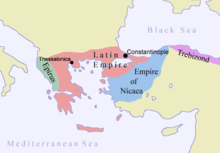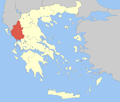Arta, Greece
Arta
Άρτα | |
|---|---|
UTC+3 (EEST) | |
| Postal code | 471 00 |
| Area code(s) | 26810 |
| Vehicle registration | ΑΤ |
| Website | www.arta.gr |
Arta (
Etymology
The origin of the city's name is quite uncertain. It is either derived from a corruption of the river Arachthos, or from the Latin word "artus" (narrow), or from the Slavic word "balta" (swamp).[2]
History
Antiquity
The first settlement in the area of the modern city dates to the 9th century B.C. Ambracia was founded as a
Middle Ages
Despite the existence of several churches from the 9th and 10th centuries, Arta is first attested only in 1082, when the


By the end of the 12th century, Arta probably formed a distinct fiscal district (
The Venetians did not take control, however, for in 1205 Michael I Komnenos Doukas came to the city, succeeded its previous Byzantine governor, and quickly established a new principality, which is known by historians as the Despotate of Epirus.[3] Arta remained the capital of the new principality for most of its history,[3] and flourished as a result. The city experienced considerable building activity, with the renovation of older churches and the construction of new ones, most notably the Church of the Parigoritissa and the Church of the Kato Panagia.[5] Sometime after 1227 it received fortifications,[5] and was the site of regional Church councils in 1213, 1219, and 1225.[3] The 15th-century Chronicle of the Tocco describes it as "the center of a fertile agricultural region with many water buffaloes, cows, and horses". The city had trade links to Venice—a Venetian consul is attested in 1284 and 1314/19[3]—and Ragusa, exporting dried meat, lard, ham, furs, and indigo. Archaeological finds also attest to a local ceramic industry.[5]
After the
In 1318, the last male-line descendant of Michael I,
Byzantine rule was unpopular,


Aided by the
From 1401/02, Carlo I Tocco, the ambitious Count of Cephalonia, began launching attacks on Arta, taking advantage of the Albanians' infighting. Despite the Albanians' calling on Ottoman aid, in 1416 Tocco captured Arta after a long siege. Having taken control of Ioannina in 1411, Tocco thus reunited the core of the old Epirote realm, and received recognition from both the Ottomans and the Byzantine emperor.[15] After Carlo I's death in 1429, he was succeeded by his nephew Carlo II Tocco. In 1449, the city fell to the Ottomans.[4]
Ottoman period
Under Ottoman rule, the town was called in Turkish Narda. It was occupied by
In 1776, the town was composed of approximately 8,000 to 10,000 Greeks, 200 Turks and 200 Jews.[16] At the time, Arta specialized in producing wheat, wine, tobacco and shipbuilding timber.[16]
Modern era
The city was finally annexed to the
In March 1944, most of the Jewish community (384 members at the time) was arrested by the Nazis and deported to the extermination camps.[17]
Climate
Arta has a hot-summer Mediterranean climate (Csa) with hot, dry summers and cool, rainy winters. Like much of Western Greece, it receives plenty of precipitation, making it one of the wettest cities in Greece.
| Climate data for Arta (1976–2010) | |||||||||||||
|---|---|---|---|---|---|---|---|---|---|---|---|---|---|
| Month | Jan | Feb | Mar | Apr | May | Jun | Jul | Aug | Sep | Oct | Nov | Dec | Year |
| Mean daily maximum °C (°F) | 13.3 (55.9) |
14.0 (57.2) |
16.7 (62.1) |
20.1 (68.2) |
25.0 (77.0) |
29.1 (84.4) |
31.8 (89.2) |
32.0 (89.6) |
29.0 (84.2) |
24.1 (75.4) |
19.0 (66.2) |
14.9 (58.8) |
22.4 (72.4) |
| Daily mean °C (°F) | 8.7 (47.7) |
9.4 (48.9) |
11.9 (53.4) |
15.2 (59.4) |
19.9 (67.8) |
24.0 (75.2) |
26.5 (79.7) |
26.5 (79.7) |
23.1 (73.6) |
18.3 (64.9) |
13.5 (56.3) |
9.9 (49.8) |
17.2 (63.0) |
| Mean daily minimum °C (°F) | 4.7 (40.5) |
5.2 (41.4) |
7.0 (44.6) |
9.9 (49.8) |
13.9 (57.0) |
17.3 (63.1) |
19.5 (67.1) |
19.9 (67.8) |
17.1 (62.8) |
13.4 (56.1) |
9.4 (48.9) |
6.0 (42.8) |
11.9 (53.5) |
| Average rainfall mm (inches) | 129.6 (5.10) |
125.4 (4.94) |
91.6 (3.61) |
81.3 (3.20) |
44.8 (1.76) |
19.8 (0.78) |
13.4 (0.53) |
14.7 (0.58) |
61.5 (2.42) |
128.3 (5.05) |
199.8 (7.87) |
189.7 (7.47) |
1,099.9 (43.31) |
| Average rainy days | 12.1 | 11.1 | 10.6 | 9.6 | 7.4 | 4.2 | 2.5 | 2.5 | 4.9 | 8.1 | 11.9 | 13.0 | 97.9 |
| Average relative humidity (%)
|
71.7 | 70.6 | 68.9 | 68.8 | 66.0 | 61.4 | 59.2 | 59.4 | 63.6 | 67.7 | 74.1 | 73.2 | 67.1 |
| Source: Hellenic National Meteorological Service [18] | |||||||||||||
Landmarks


Classical
The modern city is on the site of ancient Ambracia. Remains of the classic era include the ancient walls, the ruins of an ancient temple of Apollo, a small theatre, and remnants of the southwest cemetery.
Byzantine and later





The town's fortifications, including the Castle of Arta, were built by Michael I Komnenos Doukas in the early 13th century, but their present form is largely post-Byzantine. Secular architecture from the Byzantine period, including the palace of the Despots of Epirus, has vanished completely, but the city preserves numerous churches.[5]
The most important Byzantine church is the
Museums
- Archaeological Museum of Arta
- Church of the Paregoretissa
- Folk museum 'Skoufas'
- Historical museum 'Skoufas'
- Private folk museum in Kypseli.
- Archaeological museum of Koronisia
Education

Arta has several university departments belongs to the university of Ioannina.
Transportation
Arta is located NNW of
.Regular bus lines connect Arta with all bigger Greek cities. (bus to Athens departs several times a day and trip takes about 5 hours)
The city is linked with the GR-5 (Antirrio - Ioannina) and the GR-30 which links with Peta and Trikala. The
Municipality



The present municipality Arta was formed at the 2011 local government reform by the merger of the following 5 former municipalities, that became municipal units (constituent communities in brackets):[19]
- Amvrakikos (Aneza, Vigla, Gavria, Kalogeriko, Koronisia, Polydroso, Rachi, Strongyli, Psathotopi)
- Arta (Arta, Keramates, Kostakioi, Limini)
- Filothei (Agios Spyridon, Kalamia, Kalovatos, Kirkizates, Rokka, Chalkiades)
- Vlacherna (Vlacherna, Grammenitsa, Grimpovo, Korfovouni)
- Xirovouni (Ammotopos, Dafnoti, Kampi, Pantanassa, Pistiana, Rodavgi, Skoupa, Faneromeni)
The municipality has an area of 457.248 km2, the municipal unit 47.493 km2.[20]
Quarters of Arta
- Agia Triada
- Agioi Anargyroi
- Agios Georgios Glykorrizou
- Eleousa
- Glykorrizo
- Kato Panagia Artas
- Marathovouni
Historical population
| Year | Municipal unit | Municipality |
|---|---|---|
| 1981 | 20,004 | - |
| 1991 | 23,710 | - |
| 2001 | 23,863 | - |
| 2011 | 27,330 | 43,166 |
| 2021 | 26,999 | 41,600 |
Notable people
Ancient
- Pyrrhus (318 BC-272 BC), general and king of Epirus
- Epicrates of Ambracia (4th century BC), comic poet
- Silanus of Ambracia (5th century BC), soothsayer in Xenophon's Anabasis
- Epigonus of Ambracia (6th-5th BC), musician
Byzantine
- Michael I Komnenos Doukas, founder and first ruler of the principality of Epirus from 1205 until his death in 1215.
- Theodore Komnenos Doukas, (died c. 1253), ruler of Epirus from 1215 to 1230 and of Thessalonica from 1224 to 1230.
- canonized as Saint Theodora of Arta; (ca. 1225 – after 1270), consort of Epirus and Orthodox Christiansaint.
- Michael II Komnenos Doukas, ruler of Epirus from 1230 until his death in 1266/68.
- Nikephoros I Komnenos Doukas, (c. 1240 – c. 1297) ruler of Epirus from 1267/8 to c. 1297.
- Thomas I Komnenos Doukas,(c. 1285–1318) ruler of Epirus from c. 1297 until his death in 1318.
Modern

- Maximus the Greek (1475–1556), monk, publicist, writer, scholar, humanist and translator
- Nikolaos Skoufas (1779–1818), founder of the Filiki Eteria, from Kompoti
- Theodoros Tzinis (1798–1869), fighter of the Greek War of Independence, from Kompoti
- Hoca Ishak Efendi(1774–1835), Ottoman engineer and translator
- Joseph Stephanini (1803-?) Greek-American author, runaway slave
- Napoleon Zervas (1891–1957), WWII general and resistance leader
- Konstantinos Karapanos (1840–1911), politician and archaeologist
- Alexandros Karapanos (1873–1946), politician and diplomat
- Yiannis Moralis (1916-2009), painter
- Isaac Mizan (1927-2021), last Greek-Jewish survivor of the Auschwitz concentration camp
- Olga Gerovasili, politician
- Antonios Nikopolidis (1971), footballer
- Angeliki Stogia, politician
- Dimitris Tsironis (1960–2022), politician
Professional sports
Handball
Basketball
Football
- https://web.archive.org/web/20190207113340/http://www.anagenisiartas.gr/
- https://web.archive.org/web/20061205033543/http://doxa-artas.gr/
Volleyball
- https://web.archive.org/web/20070516144231/http://www.anagenisi-artas.gr/volley/
- http://www.filia.gr/ Archived 2008-05-15 at the Wayback Machine
See also
- Despotate of Arta
- Bridge of Arta
- Arachthos River
- Despotate of Epirus
References
- ^ "Αποτελέσματα Απογραφής Πληθυσμού - Κατοικιών 2021, Μόνιμος Πληθυσμός κατά οικισμό" [Results of the 2021 Population - Housing Census, Permanent population by settlement] (in Greek). Hellenic Statistical Authority. 29 March 2024.
- ^ Babiniotis, George (2002). Dictionary of the Modern Greek language (2nd ed.). Athens: Lexicology Center.
- ^ a b c d e f g h i j k l m n Soustal & Koder 1981, p. 113.
- ^ a b c d Soustal & Koder 1981, p. 114.
- ^ ISBN 0-19-504652-8.
- ^ Fine 1994, pp. 253–254.
- ^ Nicol 1984, pp. 108ff.
- ^ Fine 1994, pp. 254–255.
- ^ Nicol 1984, pp. 114–121, 124.
- ^ Fine 1994, p. 320.
- ^ Soustal & Koder 1981, pp. 70, 113–114.
- ^ Fine 1994, pp. 347–350.
- ^ Nicol 1984, pp. 123–138.
- ^ Fine 1994, pp. 350–351.
- ^ Soustal & Koder 1981, pp. 72–73, 114.
- ^ a b Simopoulos, Kyriakos (1973). Xenoi taxidiōtes stēn Hellada: 1700-1800 (in Greek). Simopoulos. p. 443.
O Foucherot σημειώνει ότι ο πληθυσμός της Αρτας ανέρχεται σε 8–10.000 Έλληνες , 200 Τούρκους και άλλους τόσους Εβραίους. Τα προϊόντα της περιοχής: στάρια, κρασιά, εκλεκτά καπνά και ξυλεία ναυπηγική.
- ^ "ARTA".
- ^ "Mean Arta Climatic Averages". Hellenic National Meteorological Service. Archived from the original on 16 September 2016. Retrieved 30 April 2015.
- ^ "ΦΕΚ B 1292/2010, Kallikratis reform municipalities" (in Greek). Government Gazette.
- ^ "Population & housing census 2001 (incl. area and average elevation)" (PDF) (in Greek). National Statistical Service of Greece. Archived from the original (PDF) on 2015-09-21.
- ISBN 978-0-415-34164-6. Retrieved 19 November 2010.
Sources
- ISBN 0-472-08260-4.
- ISBN 978-0-521-13089-9.
- Soustal, Peter; Koder, Johannes (1981). Tabula Imperii Byzantini, Band 3: Nikopolis und Kephallēnia (in German). Vienna: ISBN 978-3-7001-0399-8.
- Zečević, Nada (2014). The Tocco of the Greek Realm: Nobility, Power and Migration in Latin Greece (14th-15th centuries). Belgrade: Makart. ISBN 9788691944100.
External links
- Arta Prefecture Archived 2009-02-21 at the Wayback Machine
- Arta Season Bridge (discoverarta) (in English and Greek)
- Archaeological Museum of Arta (in Greek)

